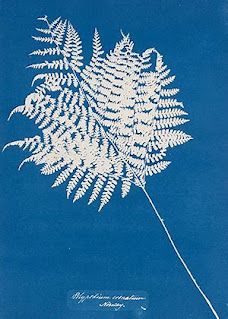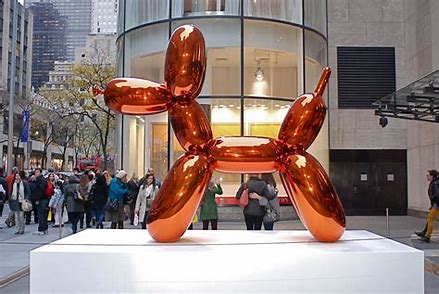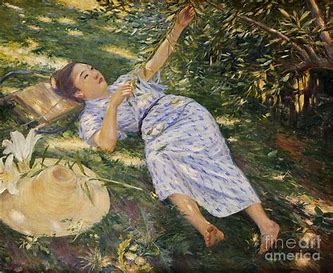Early Modern Blog
I want to apologize for any confusion my blog may have caused. In my effort to complete it over the Spring Break, I unfortunately overlooked the date of the art period given by the Professor. Therefore, two of my introduced Artists, Anna Atkins and Camille Pissarro, and their artworks don't meet the time frame requirements.
In this week's Early Modern Blog, I would like to present the development of art following innovations in science and technology. The innovation in technology in this blog will be photography. The first successful photographic experiment was a Daguerreotype, created by Louis Jacques Mande Daguerre in 1837. In late 1839, daguerreotypes that engraved images in silver-coated copper plates became popular and were produced in many nations. In early 1840, the first photography studios started appearing in the UK. Photography offered the possibility of an instant portrait that was affordable to all societal classes. Photography created a new media that was also used in science.
The first artist I would like to introduce is Anna Atkins(1799-1871). She was born in Tonbridge, Kent, UK. Anna grew up with her father, George Children, a well-known chemist, mineralogist, and zoologist. "She lost her mother very early in life and as a result formed a close bond with her father,' Andrea says. 'Her father was a well-respected scientist and the first president of the Royal Entomological Society of London, which in turn opened doors for Anna to participate in science that would not have been possible for many women at that time."(Lotzof, n.d.)
As Sir John Hershel invented the cyanotype photographic process in 1842, Anna profited from the discovery. She applied the process to plant illustrations by creating photograms that she planted on cyanotype paper. In England, the fascination with botany and especially ferns coincided with the development of photography. In 1853, Anna Atkins began to create cyanotypes of ferns, which inspired the book Cyanotypes of British and Foreign Flowering Plants and Ferns (1853), which is often considered her most accomplished publication. One of the illustrations of her mesmerizing book is a cyanotype of Polypodium crenatum, Norway 1854, from her book Cyanotypes of British and Foreign Flowering Plants and Ferns. The cyanotype measures 32.9 x 23.6 cm. It was purchased in 1983 and is currently displayed at the National Gallery of Canada, Ottawa.
Anna's cyanotypes not only introduced different types of ferns to the scientific public but were also skillfully and artistically composed. They resulted in monochromatic portraits of plants conveying melancholic and nostalgic landscapes that seemed bathed in the blue moonlight. Anna's affinity for botanical drawing enabled her impressions of plants to reveal their subjects at a particular moment and time, showcasing an exceptional degree of authenticity.
Anna Atkins was the first scientist and artist to illustrate her books with images. She pioneered publishing books with artistic photographic images, and although the books were created for scientific purposes, it doesn't make her art any less notable and influential.
Photography had an unprecedented impact on 19th-century art. Before the invention of photography, all artistic movements in Europe had the representation of realism as their primary objective. Romanticism and the Art Nouveau movements already emphasized emotion and drama; however, they were always depicted realistically. The invention of photography contributed to the development of a different perception of artistic reality, with a focus on the changing, transient moment and constant movement. Impressionism explored different approaches to the depiction of reality. It explored movement, light, and expression of the moment.
The second artist I would like to introduce is Camille Pissarro and his painting The Boulevard Montmartre on a Winter Morning. It was created in 1897 in Paris and is oil on canvas measuring 25 1/2 x 32 inches (64.8 x 81.3 cm). It is currently displayed at the Metropolitan Museum of Art, New York. "Pissarro returned to Paris, where he painted several series of the grands boulevards. Surveying the view from his lodgings at the Grand Hôtel de Russie in early 1897, Pissarro marveled that he could "see down the whole length of the boulevards" with "almost a bird's-eye view of carriages, omnibuses, people, between big trees, big houses that have to be set straight." From February through April, he recorded—in two scenes of the boulevard des Italiens to the right, and fourteen of the boulevard Montmartre to the left—the spectacle of urban life as it unfolded below his window."(Boulevard Montmartre, n.d.)

The painting portrays a busy Parisian boulevard where everything seems to move- the people, carriages, and light. Instead of using clear lines, Pissaro employs color theory to create a sense of distance. Dark and warm colors make objects appear closer, while light and cool colors create the illusion of distance. The artist excels in capturing the winter morning in Paris, where daily life unfolds in front of the viewer, vibrant, lucid, and dynamic. The artist used quick, short brush strokes, creating the impression of distance and the eternal impression of the snowy pink morning in Paris that permits the viewer to open the window and see the breathtaking beauty of Montmartre Boulevard 127 years ago.
Impressionism was not the only art movement influenced by photography. Surrealism is complementary to photography because, despite the highly realistic objects depicted in surrealistic paintings, the main focus was to challenge reality and analyze the irrational and subconscious that the camera cannot capture.
The third artist I would like to introduce to you in my blog is Salvador Dalí (1904-1989) and his painting The Persistence of Memory. The painting was created in 1931 in Paris, oil on canvas, and measures 24 x33cm (9.5x13in). It is housed in the Museum of Modern Art in New York. "Hard objects become inexplicably limp in this bleak and infinite dreamscape, while metal attracts ants like rotting flesh. Mastering what he called “the usual paralyzing tricks of eye-fooling,” Dalí painted with “the most imperialist fury of precision,” he said, but only “to systematize confusion and thus to help discredit completely the world of reality.” It is the classic Surrealist ambition, yet some literal reality is included, too: the distant golden cliffs are the coast of Catalonia, Dalí’s home."(Salvador Dalí Persistence of Memory, n.d.)
The painting depicts pocket watches slowly melting, like cheese on the skillet. The artist is said to have drawn inspiration from watching cheese/pie melt on the plate. Port Lliga, Catalonia's photographic landscape was a nod to the artist's childhood, as is the watch, surrounded by ants, which is believed to be Dalí's father's watch. The interpretation of the painting depends on the viewer, offering countless possibilities such as Dali's childhood memories, a passage from birth to death, relations between past and future, or the fleeting nature of existence. The artist used a brilliant and vivid color palette and invisible brushwork and painted the objects with utmost precision. The painting amalgamates the genres of landscape, portrait, and still life. It became an iconic representation of the surrealist movement and human exploration of the interconnectedness of existence.
“The Boulevard Montmartre on a Winter Morning.” The Metropolitan Museum of Art, www.metmuseum.org/art/collection/search/437310. Accessed 17 Mar. 2024.
Lotzof, Kerry. “Anna Atkins’s Cyanotypes: The First Book of Photographs.” Natural History Museum, www.nhm.ac.uk/discover/anna-atkins-cyanotypes-the-first-book-of-photographs.html. Accessed 17 Mar. 2024.
“Salvador Dalí. The Persistence of Memory. 1931.” MoMA, www.moma.org/collection/works/79018. Accessed 18 Mar. 2024.
Schaaf, Lary J. “The Cyanotypes of Pioneering Photographer Anna Atkins.” National Gallery of Canada, 26 Nov. 2020, www.gallery.ca/magazine/your-collection/the-cyanotypes-of-pioneering-photographer-anna-atkins.




Hello Chris,
ReplyDeleteA couple of thoughts on the photogram. I have always been curious about how blueprints got their name. Now I know! I am glad you thought of including the fact that Anna profited from this discovery. I would like to have this picture in my home. I really like the contrast of blue and white. The stem of the fern looks so delicate it’s amazing that it could bear the weight of the fern itself seeing how full it is. What I find interesting is the amazing result of a chemical reaction.
The late 19th and early 20th century were such an exciting time for scientific discoveries. Everything in our everyday lives began advancing so quickly. Being born in the late 1950s I would say nearly all of the technology we have today either did not exist then, or it was under development and not known to the public yet. I remember when I read or heard about some new advance in technology, I would think to myself it was highly unlikely that would ever come to fruition. Certainly, having a conversation with someone on a computer screen was not likely to ever happen!
Regarding the boulevard painting, there is nothing to dislike, but I would not hang it in my home. The technique he used seems to trick the eyes. I did a close inspection of it to see if I could make out any of the minute details, but then that is when it gets blurry which is the intent of the technique. I do see what you mean, that everything seems to be moving.
Regarding the painting The Persistence of Memory. Although I would not have this in my house, I do like it because it reminds me of the artwork in the book Alice in Wonderland which is surrealist and dream-like throughout. The book and movie were one of my children’s favorites.
Hello Chris, your blog post provides a interesting journey through the realms of art, science, and technology during the Early Modern period. Despite the oversight regarding the timeframe for the art period, your exploration of photography's impact on artistic expression is educational and engaging. Thank you for sharing.
ReplyDelete